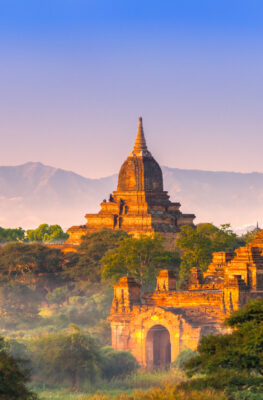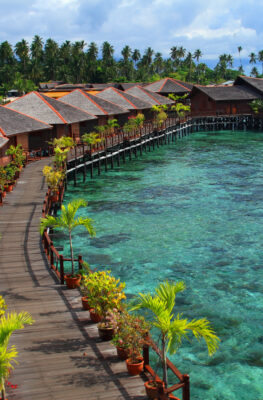Published on February 13, 2018
Bus terminal in Yangon, Myanmar. Image courtesy of Mike Aquino.
Take it from one avid traveler: bus travel in Southeast Asia is not only practical, it’s super-friendly to the environment, too.
“As a responsible traveler, I try to offset harmful airplane emissions by traveling overland by bus, shared van, or train wherever possible,” says Lola Méndez of Miss Filatelista (Facebook|Twitter|Instagram). “In Southeast Asia this is especially easy as many countries are relatively compact and buses are comfortable and affordable.”
With coverage (and limited environmental footprint) in mind, we’ve asked a few bloggers about the best places they reached by bus, and the answers were just as varied as the many highways in the region.
Kampot roundabout, Cambodia. Image courtesy of Sarah Rothrie.
Riding the Bus in Cambodia
Cambodia’s developing transportation network puts some of its country’s best tourism attractions some way beyond the beaten path. Thus it is with Kampot, observes Sarah Rothrie of TripGourmets (Facebook|Instagram|Twitter).
“Unlike neighbouring Vietnam and Thailand, Cambodia doesn’t have an extensive rail network, and there is no airport in Kampot,” Sarah explains. “So the only practical way to reach it is by bus from Phnom Penh.
“There are numerous companies operating bus services of varying quality. We can strongly recommend using Giant Ibis, one of the best and most respected bus operators in Cambodia.”
The trip takes no longer than three hours, and is completely worth it, says Sarah.
“Kampot, Cambodia is a river city located close to the coast on the south of the country, near to the Vietnamese border,” she tells us. “Much of its charm comes from the dilapidated French colonial architecture that lines the streets by the riverside and around the small city centre. Attractions in the area include river kayaking, the Bokor National Park and the seaside village of Kep, where you can eat freshly caught crab with sauce made from locally-grown Kampot green peppercorns.”
For a dazzling beach town only a little further from Phnom Penh, James Cave of Worldwide Shopping Guide (Facebook|Twitter) suggests that you “relax and recharge your batteries” in the coastal town of Sihanoukville.
“The town itself is laid-back, so much so that it’s almost impossible not to relax and unwind here,” James says. “[You’ll get] several postcard-perfect beaches to explore, a great selection of restaurants to enjoy, and accommodation options to suit every budget.
“In the very unlikely event that you don’t want to just relax and enjoy Sihanoukville’s beautiful beaches, the beautiful Leu Pagoda is well-deserving of your attention,” James continues, “as are the food markets Phsar Pinichicom and Phsar Leu.”
The vast majority of tourists come to Sihanoukville by bus, despite the presence of a nearby airport and a new train line. “The journey from Phnom Penh is relatively short at just four hours, and there are multiple services every day,” James explains. “Most buses have Wi-Fi and AirCon as well, making the already easy-going journey even more comfortable.”
Cameron Highlands tea plantations, Malaysia. Image courtesy of Tourism Malaysia.
Riding the Bus in Malaysia
From the Malaysian capital Kuala Lumpur, several very well-developed highways lead east, north and south to peninsular Malaysia’s most scenic out-of-the-way settlements.
Up in the mountains some 250 km north of the capital, the hill resort of Cameron Highlands subverts travelers’ expectations of Malaysia as all beach or jungle. It’s “a 3.5-hour bus trip north from Kuala Lumpur,” explains Andra Padureanu of Our World to Wander, “the perfect escape from the heat and hustle of the capital. In the heart of Cameron Highlands, you will find Tanah Rata, a small town nestled at 1,440m.
“What immediately strikes you, right from when you get off the bus in Tanah Rata, is the air, the fresh air coming from the lush jungles that surround you,” Andra says. “So it will be difficult to not go jungle trekking, at least for one day.
“The jungle trek that we chose got us through a mossy forest in the first part and then led us through amazing tea plantations. All the trails are numbered, you can easily follow the paths without any risks of getting lost.”
Stadthuys, Melaka, Malaysia. Image courtesy of Tourism Malaysia.
Go south from Kuala Lumpur instead, and you’ll find a completely different experience awaiting you there. The UNESCO World Heritage site of Melaka is “a lovely colorful town 130km and 2 hours from Kuala Lumpur,” explains Campbell Louw of Stingy Nomads. “It’s very easy to get here – buses leave every 15-30 minutes from Kuala Lumpur’s TBS-BTS Terminal, there is no need to buy a bus ticket beforehand, you can do it upon arrival, price US$3. All buses are comfortable and have AC.
“Melaka is famous for its river, beautiful embankment with colorful houses and weekend night market, where you can find all sort of local delicacies; sweets, pastry, fish, sea food, kebabs, milkshakes and more,” Campbell continues. “Don’t miss a night ride in a traditional Melaka cycle trishaw, both children and adults will enjoy it.”
Banaue Rice Terraces, Philippines. Image courtesy of Sarah Hughes.
Riding the Bus in the Philippines
From the Philippines’ capital Manila, several highways traverse the island of Luzon to beaches and islands far beyond any airport’s reach.
The Mountain Province in Luzon’s elevated north offers a look at one of the Philippines’ most well-preserved pre-colonial cultures, the Ifugao, whose lifestyle permeates two very well-known sites in the highlands.
The Banaue Rice Terraces can easily be reached directly from Manila, explains Sarah Hughes of Live, Dream, Discover (Facebook|Twitter). “The best way to reach the Rice Terraces is by the Ohayami overnight bus – it’s by no means luxury but unless you have the budget for private transportation it’s really the only option,” she tells us. “Just make certain to book in advance as the limited schedule means that they fill up.”
Once you get there, you’ll understand why the Banaue Rice Terraces are often called the “8th Wonder of the World”, Sarah explains. “These terraces were carved into the mountainside over 2,000 years ago and reach heights of 1500m above sea level,” she says. “To this day the Ifugao people, descendants of the original terrace creators, farm the fields by hand.
“There are several other clusters of terraces in the Philippine Cordilleras and, unlike Banaue, some of them are listed as UNESCO World Heritage Sites,” Sarah says. “Plan to stay for a minimum 2-3 nights and explore at least Batad and Happao as well as the Banaue terraces.”
The town of Sagada nestles close to the Rice Terraces; many tourists make a package deal of both places. From Manila, explains Katherine Cortes of Taralets Anywhere (Facebook|Instagram), you have two options: “There are buses that go directly to Sagada from Metro Manila,” she tells us. “Another option is to take a bus to either Banaue or Baguio and then transfer to a van or bus heading to Sagada. Travel time from Manila is approximately 12 hours.”
In Sagada, the Ifugao showcase their culture and history through museums and handicrafts. “You can visit museums, watch the craft of traditional weaving and bring home souvenirs such as bags, taste the local cuisine and drinks (Bugnay wine or their own coffee brew), or explore the hanging coffins used by the locals in the old times,” Katherine says. “You can also go spelunking, swim in waterfalls and trek to rice terraces.
“Lastly, you can simply relax in cosy homestays and enjoy the chill temperature up there in the mountains.”
Church of St. Michael the Archangel in Caramoan, Philippines. Image courtesy of Kevin del Prado.
From Manila, going to the southeastern corner of Luzon takes you to one of the Philippines’ most unspoiled beach destinations. “Camarines Sur has gained a lot of attention after several franchises of Survivor were shot in the location,” explains Kevin del Prado of The Outcast Journey (Instagram|Facebook).
“This place is located in the the Bicol Region, at the tail of the largest island in the Philippines, Luzon, which can be accessed easily by bus,” Kevin tells us. “Trips from Manila are scheduled to leave every hour.
“Although going to Camarines Sur is approximately 8 hours, the long trip is totally worth it as it is the main gateway to the area’s beautiful and astonishing beaches and landscapes,” Kevin continues. “It’s also a go to destination for travelers looking for activities such as wakeboarding, surfing, and even off road adventures using ATVs.”
The kicker: it’s really inexpensive to visit. “Our whole trip in Camarines Sur with a side trip to Albay is on a budget,” Kevin says. “In fact, we only spent less than 6,000 pesos (around US$120) – we were able to cover a lot!”
Cross-Country Hops by Bus
We heard from Lola Méndez of Miss Filatelista much earlier: now, she tells us about the best way to travel from country to country in Southeast Asia, by way of an eight-chop journey from Brunei to Malaysia.
The Bandar Seri Begawan– Kota Kinabalu route “seems fairly simple but was actually quite complex,” Lola tells us. “Once we were on the road it was a fairly smooth trip, the roads were well paved and traffic was minimal. What was really dizzying was the customs process!
“The cross-country road takes you from Brunei to the state of Sarawak, Malaysia,” Lola explains. “From there you cross back into Brunei, and then back into Sarawak, Malaysia, again. A short drive later you cross over from Sarawak, Malaysia to Sabah, Malaysia. Even though both are part of the same country they require separate entry and exit stamps!
“We got eight passport stamps, just during this one bus trip!” Lola laughs. “I had never experienced that before and was quite amused. We were widely unsure of which country we were actually standing in for over an hour as we went in and out of customs border control offices!”
By contrast, the Malaysia-Thailand border hop is simplicity itself. “Border-crossing [from Kota Bharu, Malaysia to Thailand is] a ten-minute affair,” says Aditi Shukla of Lyf&Spice (Facebook|Twitter|Instagram). “We reached the Sungai Golok border by car, got our visa stamped and then went on foot to Thailand. After getting a visa–check at the Thai Office, we took a bike taxi to the bus station.
Aditi and friend had only one objective after their Thailand border-hopping experience: “We decided to head to Hat Yai, Thailand for its popular fried chicken and other street food, to get a relaxing foot massage done and to invest in some fabrics and clothes. Of course, we went pub-hopping as well.”
Bena, one of the traditional villages near Bajawa, Flores, Indonesia. Image courtesy of Cycloscope.net.
Bus Rides Further Off the Beaten Path
Many destinations in Southeast Asia aren’t just practical to reach by bus – sometimes, buses are the only way to get there.
Daniele & Elena of Cycloscope (Twitter|Facebook|Instagram) braved the buses around Flores Island in Indonesia, the only way to travel on this rugged outcrop east of Bali.
“Flores is becoming more and more popular among the more adventurous tourists, mostly fed up with the crowds of Bali and the Gili islands,” the duo tell us. “Even though most of them stick to the western part, using Labuan Bajo as a base to explore Komodo area, there’s much more to see in Flores.
“From Labuan Bajo there are several bus options – we suggest asking your hotel to help you find a Bemo. Bemos are minibusses used by locals, loaded with all sort of things, from chickens to fridges. You can also just stay on the road and wave the first passing Bemo, they’ll pick you up and drop wherever you want.
“Prices are ridiculously low (bargain if you think they’re overcharging). The riding times may scare you at first but you won’t regret spending hours this way, the landscape of Flores island is constantly stunning.
“The perfect way to travel Flores by bus is to stop for one or two nights in Ruteng (to see the spiderweb rice fields), then Bajawa and its ancestral villages, before making it to Moni to see the colorful volcanic lakes of Kelimutu.”
In Myanmar, Teresa Gomez of Brogan Abroad (Twitter|Facebook|Instagram) headed off from the temple town of Bagan to a favorite trekking jump-off point for backpackers, the mountain town of Kalaw.
“To get to Kalaw I took the overnight bus from Bagan, which was due to arrive around 6am – or so I was told. Instead, it arrived at 3am. I decided to stay up at a 24-hour tea house until 8am, when I would be setting off for a 3-day trek to Inle Lake. It was a long wait, so I recommend getting a place to stay even if it’s just for a few hours.”
The town itself is just the start of an entirely new Myanmar adventure. “Kalaw is a former British hill station, and tends to be more of a passing town for most visitors, whose main reason to travel here is to start the trek,” Teresa says. “This 3-day hike is one of the most memorable things you can do in Myanmar. It starts in Kalaw and it continues through the mountains of the Southern Shan State all the way to Inle Lake.
“The trek is reasonably easy, with the odd hill and plenty of views of mountains and valleys stretching across the landscape,” Teresa tells us. “But the best thing about this trek is the hill tribe villages it takes you through. Stopping to rest in the villages gives you the opportunity to interact with the locals and they may even invite you for a cup of tea!”






